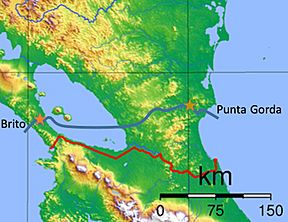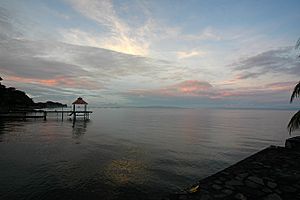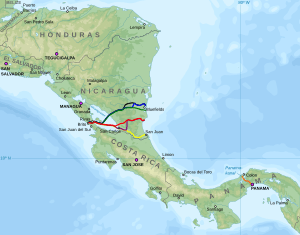Nicaragua Canal facts for kids
Quick facts for kids Nicaragua Canal |
|
|---|---|

Nicaragua Canal Project (2014) (blue line). Stars indicate the proposed Brito and Camilo Locks. The red line is the border between Nicaragua (above) and Costa Rica (below).
|
|
| Specifications | |
| Length | 270 km (170 miles) |
| Status | Abandoned |
| History | |
| Original owner | HK Nicaragua Canal Development Investment |
| Date of act | 2013 |
| Geography | |
| Start point | Punta Brito |
| End point | Bluefields |
The Nicaraguan Canal (in Spanish: Spanish: Canal de Nicaragua) was a big idea for a new shipping route through Nicaragua. It was also called the Nicaragua Grand Canal. The plan was to connect the Caribbean Sea (part of the Atlantic Ocean) with the Pacific Ocean.
This project caused a lot of worry. Scientists were concerned about its impact on the environment. Lake Nicaragua is a very important source of fresh water for Central America. Also, many shipping experts and engineers wondered if the project could actually work.
The idea of building a canal using the San Juan River and Lake Nicaragua is very old. It was first suggested hundreds of years ago. The United States even thought about building a canal here in the early 1900s. But they decided not to after they bought the rights to build the Panama Canal instead.
In June 2013, Nicaragua's government approved a deal. They gave a company called HK Nicaragua Canal Development Investment Group (HKND) the right to build and manage the canal. This company was led by a Chinese businessman named Wang Jing. The deal was for 50 years and could be extended for another 50 years.
By 2015, news reports said the project might be delayed or even stopped. This was because Wang Jing's personal wealth dropped a lot after a stock market crash in China. The Nicaraguan government also struggled to show how the project would be paid for. This made people doubt if it would ever be finished.
By May 2017, no real building work had started. More doubts grew about how it would be funded. In February 2018, many experts thought the project was over. Even though the project leader said work was still happening, HKND closed its main offices in April 2018. Despite this, the Nicaraguan government still plans to take over land under a special canal law.
Contents
Canal History: A Big Idea
For a long time, before the Panama Canal opened in 1914, Nicaragua was a key place for trade. Goods were moved across the land between ships on the Atlantic and Pacific oceans. People have thought about building a waterway through Central America for centuries. Early surveys were done by the Spanish colonial government. They looked at routes through Nicaragua, Panama, or Mexico.
The idea of a Nicaragua canal goes back to at least 1825. That's when a group called the Federal Republic of Central America hired people to study a route through Lake Nicaragua. Many other plans followed over the years. Even after the Panama Canal opened, interest in a Nicaragua canal continued.
As global trade grew and fuel costs increased, the Panama Canal started to have limits. Some ships were just too big. This made the idea of a second canal in Central America more appealing. In 2006, Nicaragua's president, Enrique Bolaños, said he wanted to move forward with such a project. Even with the Panama Canal expansion project (which opened in 2016), some very large ships still couldn't fit.
In September 2012, the Nicaraguan government signed a deal with the new Hong Kong Nicaragua Canal Development Group. HKND promised to pay for and build the "Nicaraguan Canal and Development Project." HKND Group was a private company.
In June 2013, Nicaragua's government officially approved the deal with HKND. This gave HKND the only rights to plan, design, build, and then run the canal. It also included other projects like ports, a special trade zone, and an airport. The agreement was for 50 years and could be renewed for another 50 years. HKND was supposed to pay Nicaragua US$10 million each year for 10 years. After that, Nicaragua would get a part of the money earned from the canal.
HKND Group studied the project to see if it was possible. They looked at the technology needed and if it made economic sense. They also studied how it might affect the environment and local communities. The canal and other projects were meant to be paid for by investors from all over the world. They hoped it would create many jobs for Nicaragua and other Central American countries.
HKND believed that as global trade grew and ships got bigger, there would be a strong need for a second canal. They thought that by the 2020s, the Panama Canal would become too busy. They predicted that by 2030, the amount of trade a Nicaragua Canal could handle would increase by 240%.
On June 13, 2013, Nicaragua's government passed the law to allow the project. On June 15, President Daniel Ortega and HKND chairman Wang Jing signed the agreement. Wang Jing said he had found global investors for the $40 billion project. In January 2014, Wang and President Ortega announced that building would start in December 2014 and finish by 2019.
In July 2014, a 278-kilometer (173-mile) route for the canal was approved. It would start at the Brito River on the Pacific side, go through Lake Nicaragua, and end at the Punta Gorda River on the Caribbean side. The canal was planned to be between 230 and 520 meters (750 and 1,700 feet) wide and 27.6 meters (90 feet) deep. An artificial lake of 400 square kilometers (150 sq mi) would also be created. This lake would provide water for the canal's huge locks, not Lake Nicaragua itself.
President Daniel Ortega believed the canal would help Nicaragua escape poverty. He thought it would create 250,000 jobs. However, HKND said the project would create 50,000 jobs, with about half coming from outside Nicaragua, mostly China.
In 2014, news reports said Russia was willing to help build the canal. They saw it as a chance to have a stronger presence in the region. Construction officially started in December 2014. But concerns grew about the project's future due to Nicaragua's weather and earthquakes. In November 2015, HKND announced delays in building the locks and digging until late 2016.
By November 2016, a canal official said major work should start by the end of the year. However, many believed the project wouldn't happen unless the Chinese government got involved.
In April 2018, HKND closed its main offices in China. Despite this, the Nicaraguan government said it would continue to take over land under the canal law. This law allows the government to take land for the canal and other related projects. It also makes it hard for people to challenge these decisions and offers very low payment for their land. This has led to protests. Activists believe the canal contract should be canceled because the company didn't get enough money to start the project by a certain deadline.
Protests Against the Canal
Soon after the project officially began, people started protesting. Many farmers were worried they would lose their land and homes.
Some leaders called the deal a "scam." Legal challenges against the deal were rejected by Nicaragua's highest court. The law even changed to protect HKND from legal challenges. HKND was given the right to take land up to 5 kilometers (3 miles) on each side of the canal. They would pay only a very low value for the property, not its actual market price. However, Wang Jing had promised to pay fair market value.
Estimates for how many people would be forced to move ranged from 29,000 to over 100,000. There were signs of strong local opposition to these land takeovers. Human rights groups criticized the government for not considering how the project would affect its citizens. They said people were not included in the decision-making. A company that studied the environmental impact said they talked to about 6,000 people. They estimated that about 30,000 people's property would be affected. However, national polls showed that about 70% of people supported the project.
Why the Project Ended
The main investor, Wang Jing, faced financial problems not related to the canal. He lost a lot of his money during a stock market crash in China. By March 2017, the public relations company working for Wang in Nicaragua was let go because there was nothing new to report. Wang himself had not visited Nicaragua in over two years.
In May 2017, news reports said "no concrete action has been taken to begin the project." They suggested the project was either "stopped, or nonexistent." In September 2017, it was reported that work had been "pushed back indefinitely."
By February 2018, many experts and activists believed the canal project was finished. China seemed to be focusing its investments more on Panama, which is the main competitor to a Nicaraguan canal. As mentioned, HKND finally closed its offices in April 2018.
Even though HKND stopped trying to build the canal, the Nicaraguan government still holds the legal rights from the 2013 law. This includes rights for other large building projects in Nicaragua, like ports, roads, railways, and an airport.
Canal Design and Features

The canal was planned to be 259.4 kilometers (161.2 miles) long and have three main parts.
- The West Canal would run from Brito on the Pacific Ocean. It would cross a mountain range and enter Lake Nicaragua. This part would be 25.9 kilometers (16.1 miles) long.
- The Lake Nicaragua section would be 106.8 kilometers (66.4 miles) long. A channel would need to be dug in the lake because it's not deep enough for very large ships.
- The Eastern Canal would be the longest part at 126.7 kilometers (78.7 miles). It would go through a river valley and mountains to reach the Caribbean Sea.
Both the West and East canals would have a lock system. Each lock would have three connected chambers to lift ships to the level of Lake Nicaragua. The lake's water level is about 31.3 meters (102.7 feet) above sea level. The western Brito Lock would be 14.5 kilometers (9.0 miles) from the Pacific. The eastern Camilo Lock would be 13.7 kilometers (8.5 miles) from the Caribbean Sea.
These locks would be very large: 520 meters (1,700 feet) long, 75 meters (246 feet) wide, and 27.6 meters (90.6 feet) deep. This size would allow much larger ships to pass through than even the expanded Panama Canal. For example, the new locks in Panama are 427 meters (1,401 feet) long, 55 meters (180 feet) wide, and 18.3 meters (60 feet) deep.
The plan was not to use water from Lake Nicaragua for the locks. Instead, water would come from local rivers and be recycled using special basins. The Camilo lock would have been built next to a new dam on the Punta Gorda River. This dam would create a new lake called Atlanta Reservoir, covering 395 square kilometers (153 sq mi). Another smaller reservoir would also be created. A power plant at the dam would generate electricity for the Camilo Lock.
At each ocean entrance, there would be breakwaters and port facilities. The Pacific port would be called Brito Port and the Caribbean one Aguila Port. These ports would help with construction and then become international ports. They were designed to handle millions of shipping containers each year. Existing ports in Nicaragua would also be improved.
Other plans included:
- A free trade zone with shops and tourist hotels.
- An international airport near Rivas.
- Improvements to roads, including a bridge over the canal for the Pan-American Highway.
- A ferry service on Lake Nicaragua.
The project estimated that about 3,700 people would work on the canal by 2020, and 12,700 by 2050. Ships would take about 30 hours to pass through the canal. It was predicted that over 3,500 ships would use the canal each year by 2020.
Building the Canal
No major construction work actually took place. Big jobs like digging the canal were planned to start only after a Pacific Ocean wharf (a dock) was built.
Some people worried because Wang Jing and his HKND Group didn't seem to have much experience with huge building projects.
In December 2014, Wang Jing announced that construction had started in Rivas, Nicaragua. The plan was to build the canal and other supporting structures in four main stages:
- Pre-construction: Getting permits, buying land and machinery, and finishing designs.
- Early construction: From December 2014 to September 2015. This involved getting access to building sites.
- Construction: From September 2015 to March 2020. This was when the canal would be dug and the locks built.
- Commissioning: From April 2020 to June 2020. This included testing the locks and training workers.
HKND said this project would be the biggest earth-moving operation in history. It would involve digging out huge amounts of rock and soil. There would also be a lot of dredging (digging up the bottom) in Lake Nicaragua and the oceans. The dug-up material would be placed in special areas near the canal.
Two concrete plants and a steel plant were planned to support the project. Cement would likely be imported, but building materials like gravel would come from local quarries.
HKND estimated that about 50,000 people would work during the five years of construction. About half would be from Nicaragua, 25% from China, and the rest from other countries. Workers would live in special camps with food, shelter, health care, and security. They would work 12-hour shifts, 7 days a week.
How it Was Paid For
The project was estimated to cost between $40 billion and $50 billion. Wang Jing provided some money to start, and more money was expected from investors. There was talk of selling shares in the company to the public. A Chinese construction company, XCMG, was supposed to provide machinery and get shares in HKND in return.
By the end of 2014, no major investors had been publicly named. There was talk that the Chinese government would help pay, but both China and Wang denied this. Wang Jing lost a lot of his money during the 2015 Chinese stock market crash. Nicaragua is one of the poorest countries in Latin America.
Wang admitted that the project had financial, political, and engineering risks. The project was very expensive, with some estimates reaching $100 billion, and it was not fully funded. The Nicaraguan government's bank reserves were used as a guarantee, but HKND didn't have to provide such a guarantee.
As mentioned, HKND closed its main offices in China in April 2018 due to financial problems.
Impact of the Canal Project
Environmental Concerns
Building the canal would have destroyed the natural homes of at least 22 endangered animal species. A big worry was how the project would affect Lake Nicaragua. This lake is the largest source of fresh water in Nicaragua. An oil spill in the lake would have very serious and long-lasting effects. Other problems included:
- Dredging (digging up the lake bottom) could bring up toxic mud.
- It could disrupt the migration paths of animals.
- It might introduce new, harmful species to the lake.
Environmental studies were not released by HKND when the project officially started. The Nicaraguan Academy of Sciences said that huge areas of forests and wetlands would be destroyed. They also pointed out that the environmental study done for the canal was not truly independent.
President Daniel Ortega said he wasn't worried about harming the lake because it was "already contaminated." However, protesters feared the canal would cause massive environmental damage to Lake Nicaragua and other areas. It would destroy 400,000 hectares (about 1.5 million acres) of tropical rain forest and wetlands. It would also affect animals like the Baird's tapir, spider monkey, and jaguar.
Economic Impact
The original Panama Canal still has room for many ships. Also, the Panama Canal expansion project added more capacity for even larger ships. Because of this, some people thought the predictions for how much traffic the Nicaragua Canal would get were too hopeful.
While the Nicaragua Canal would have been wide enough for the very largest container ships, called Triple E class, only a few ports in the world can handle these ships right now. Also, a railway line might be built by China in Honduras. This could also affect how many ships would use the Nicaragua Canal. Shipping goods across North America by train, using Pacific ports in Mexico and the United States, would also compete for trade between Asia and the U.S. east coast. So, competition might have made the Nicaragua Canal not profitable if it had been built.
The canal would have affected nearby countries like Honduras and El Salvador. These countries are part of a trade agreement. Their economies would have been influenced by more trade and cooperation.
Social Impact
According to an official study, the canal would have required about 30,000 people to move from their homes. However, a human rights group, Amnesty International, said it would "forcibly displace an estimated 120,000 people." This included indigenous communities. The report claimed that foreign visitors, guarded by Nicaraguan authorities, were measuring people's land. It also said that laws passed by the government allowed HKND to take any land it wanted. It also denied displaced families the right to challenge these decisions.
Amnesty International also stated that Nicaraguan officials used too much force and made unfair arrests. However, the Nicaraguan government's report in 2015 said: "The Nicaraguan government and HKND will guarantee that persons and families on the route of the canal's construction will have living conditions superior to those they currently have."
See also
 In Spanish: Canal de Nicaragua para niños
In Spanish: Canal de Nicaragua para niños


